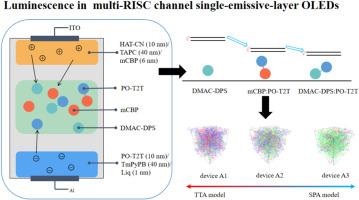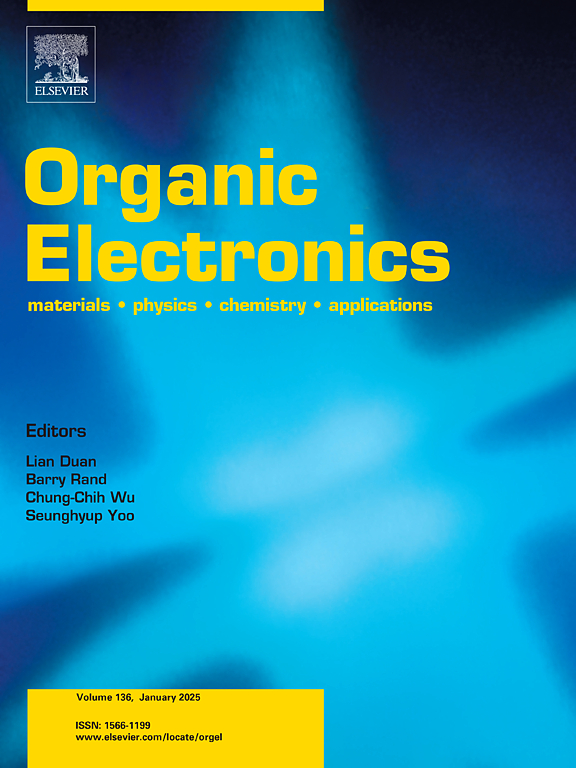多risc通道单发射层有机发光二极管的电致发光性能分析
IF 2.6
4区 工程技术
Q3 MATERIALS SCIENCE, MULTIDISCIPLINARY
引用次数: 0
摘要
随着技术的进步,利用多反向系统交叉(RISC)通道的高效有机发光二极管(OLED)器件被越来越多地报道。多risc通道策略已成为一种高度可行的OLED设计方法。然而,由于EML中存在多种不同类型的分子,多risc通道单发射层oled的分析仍然面临许多挑战。本文基于实验、分子动力学(MD)模拟和量子化学计算,系统分析了掺杂浓度对多risc通道单发射层oled电致发光性能的影响。认为掺杂浓度对多risc通道单发射层oled电致发光性能的影响主要归因于发射层中载流子的重组顺序、发射复合物周围分子极性变化引起的激振态能级的波动以及不同效率滚转模型之间的过渡。这项工作为提高多risc通道单发射层oled的效率提供了新的途径和分析方法。本文章由计算机程序翻译,如有差异,请以英文原文为准。

The analysis of the electroluminescence performance of multi-RISC channel single-emissive-layer organic light-emitting diode
With the advancement of technology, an increasing number of high efficiency organic light-emitting diode (OLED) devices utilizing multi-reverse intersystem crossing (RISC) channels have been reported. The multi-RISC channel strategy has emerged as a highly feasible OLED design approach. However, the analysis of multi-RISC channel single-emissive-layer OLEDs still faces numerous challenges due to the presence of multiple different kinds of molecules in the EML. Herein, based on experiments, molecular dynamics (MD) simulations, and quantum chemical calculations, a systematic analysis has been conducted on the impact of doping concentration on the electroluminescence performance of multi-RISC channel single-emissive-layer OLEDs. It is believed that the impact of doping concentration on the electroluminescence performance of multi-RISC channel single-emissive-layer OLEDs is attributed to the charge carrier recombination order in the emitting layer, the fluctuation of the excited state energy level of exciplex caused by the change in molecular polarity surrounding the emissive exciplex, and the transition between different efficiency roll-off models. This work provides new pathways and analysis methods to enhancing the efficiency of multi-RISC channel single-emissive-layer OLEDs.
求助全文
通过发布文献求助,成功后即可免费获取论文全文。
去求助
来源期刊

Organic Electronics
工程技术-材料科学:综合
CiteScore
6.60
自引率
6.20%
发文量
238
审稿时长
44 days
期刊介绍:
Organic Electronics is a journal whose primary interdisciplinary focus is on materials and phenomena related to organic devices such as light emitting diodes, thin film transistors, photovoltaic cells, sensors, memories, etc.
Papers suitable for publication in this journal cover such topics as photoconductive and electronic properties of organic materials, thin film structures and characterization in the context of organic devices, charge and exciton transport, organic electronic and optoelectronic devices.
 求助内容:
求助内容: 应助结果提醒方式:
应助结果提醒方式:


